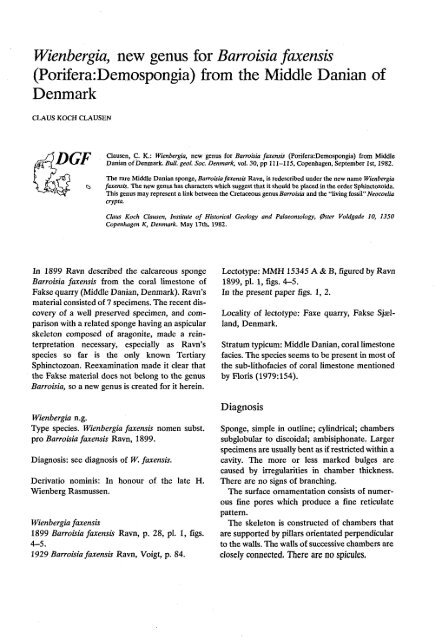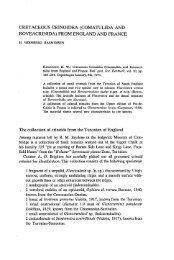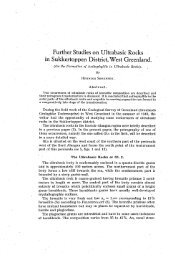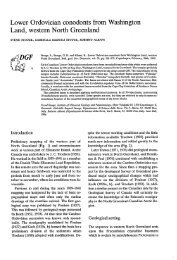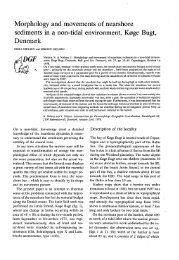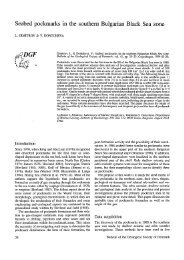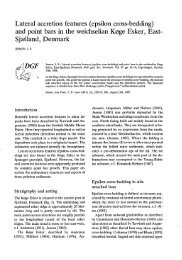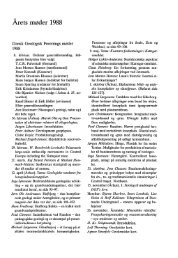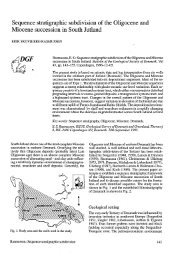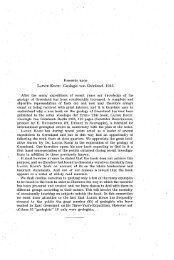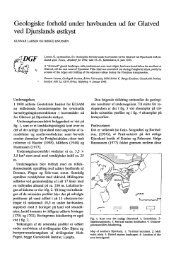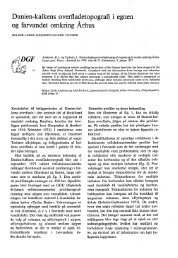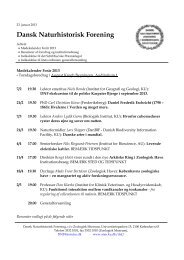Bulletin of the Geological Society of Denmark, Vol. 30/3-4, pp. 111-115
Bulletin of the Geological Society of Denmark, Vol. 30/3-4, pp. 111-115
Bulletin of the Geological Society of Denmark, Vol. 30/3-4, pp. 111-115
Create successful ePaper yourself
Turn your PDF publications into a flip-book with our unique Google optimized e-Paper software.
Wienbergia, new genus for Barroisia faxensis<br />
(Porifera:Demospongia) from <strong>the</strong> Middle Danian <strong>of</strong><br />
<strong>Denmark</strong><br />
CLAUS KOCH CLAUSEN<br />
/^^~ T E' Clausen, C. K.: Wienbergia, new genus for Barroisia faxensis (Porifera:Demospongia) from Middle<br />
M*J\JÆ Danian <strong>of</strong> <strong>Denmark</strong>. Bull. geol. Soc. <strong>Denmark</strong>, vol. <strong>30</strong>, <strong>pp</strong> <strong>111</strong>-<strong>115</strong>, Copenhagen, September 1st, 1982.<br />
il The rare Middle Danian sponge, Barroisia faxensis Ravn, is redescribed under <strong>the</strong> new name Wienbergia<br />
i> es faxensis. The new genus has characters which suggest that it should be placed in <strong>the</strong> order Sphinctozoida.<br />
V This genus may represent a link between <strong>the</strong> Cretaceous genus Barroisia and <strong>the</strong> "living fossil" Neocoelia<br />
crypta.<br />
Claus Koch Clausen, Institute <strong>of</strong> Historical Geology and Palaeontology, Øster <strong>Vol</strong>dgade 10, 1350<br />
Copenhagen K, <strong>Denmark</strong>. May 17th, 1982.<br />
In 1899 Ravn described <strong>the</strong> calcareous sponge<br />
Barroisia faxensis from <strong>the</strong> coral limestone <strong>of</strong><br />
Fakse quarry (Middle Danian, <strong>Denmark</strong>). Ravn's<br />
material consisted <strong>of</strong> 7 specimens. The recent discovery<br />
<strong>of</strong> a well preserved specimen, and comparison<br />
with a related sponge having an aspicular<br />
skeleton composed <strong>of</strong> aragonite, made a reinterpretation<br />
necessary, especially as Ravn's<br />
species so far is <strong>the</strong> only known Tertiary<br />
Sphinctozoan. Reexamination made it clear that<br />
<strong>the</strong> Fakse material does not belong to <strong>the</strong> genus<br />
Barroisia, so a new genus is created for it herein.<br />
Wienbergia n.g.<br />
Type species. Wienbergia faxensis nomen subst.<br />
pro Barroisia faxensis Ravn, 1899.<br />
Diagnosis: see diagnosis <strong>of</strong> W. faxensis.<br />
Derivatio nominis: In honour <strong>of</strong> <strong>the</strong> late H.<br />
Wienberg Rasmussen.<br />
Wienbergia faxensis<br />
1899 Barroisia faxensis Ravn, p. 28, pi. 1, figs.<br />
4-5.<br />
1929 Barroisia faxensis Ravn, Voigt, p. 84.<br />
Lectotype: MMH 15345 A & B, figured by Ravn<br />
1899, pi. 1, figs. 4-5.<br />
In <strong>the</strong> present paper figs. 1, 2.<br />
Locality <strong>of</strong> lectotype: Faxe quarry, Fakse Sjælland,<br />
<strong>Denmark</strong>.<br />
Stratum typicum: Middle Danian, coral limestone<br />
facies. The species seems to be present in most <strong>of</strong><br />
<strong>the</strong> sub-lith<strong>of</strong>acies <strong>of</strong> coral limestone mentioned<br />
by Floris (1979:154).<br />
Diagnosis<br />
Sponge, simple in outline; cylindrical; chambers<br />
subglobular to discoidal; ambisiphonate. Larger<br />
specimens are usually bent as if restricted within a<br />
cavity. The more or less marked bulges are<br />
caused by irregularities in chamber thickness.<br />
There are no signs <strong>of</strong> branching.<br />
The surface ornamentation consists <strong>of</strong> numerous<br />
fine pores which produce a fine reticulate<br />
pattern.<br />
The skeleton is constructed <strong>of</strong> chambers that<br />
are su<strong>pp</strong>orted by pillars orientated perpendicular<br />
to <strong>the</strong> walls. The walls <strong>of</strong> successive chambers are<br />
closely connected. There are no spicules.
112 Clausen: Wienbergia<br />
Differential diagnosis<br />
Wienbergia n.g. is different from <strong>the</strong> Cretaceous<br />
Barroisia by not possesing spicules in a systematic<br />
arrangement. Wienbergia n.g. differs from<br />
Neocoelia in being much larger, bending and<br />
presumably by not being branching.<br />
Relationship<br />
The relationship between Barroisia and related<br />
sphinctozoida has been examined by Reid<br />
(1968). He concluded that <strong>the</strong> genus Barroisia,<br />
which is restricted to <strong>the</strong> Cretaceous (England),<br />
and <strong>the</strong> closely related Tremacystia <strong>of</strong> same age,<br />
contain spicules in a systematic arrangement, and<br />
he redefined (Reid, 1968:9) <strong>the</strong>se two genera on<br />
<strong>the</strong> basis <strong>of</strong> this arrangement.<br />
In contrast, some o<strong>the</strong>r sphinctozoans do not<br />
possess spicules and, according to Reid (1968),<br />
this indicates that <strong>the</strong> group is polyphyletic.<br />
Vacelet (1978) tried to solve this problem by<br />
erecting a new order, Sphaerocoelida for Cretaceous<br />
sponges having sphinctozoan structure<br />
and a skeleton <strong>of</strong> calcareous spicules, and placed<br />
this order within <strong>the</strong> Class Calcispongea. The<br />
Sphaerocoelida are thus regarded as<br />
homeomorphs <strong>of</strong> <strong>the</strong> Sphinctozoa, which Vacelet<br />
(1978) has shown to be an order <strong>of</strong> <strong>the</strong> class Demospongea.<br />
Vacelet (1977) has described a living<br />
sphinctozoan from <strong>the</strong> Indian Ocean and New<br />
Caledonia. The skeleton <strong>of</strong> this form, Neocoelia<br />
crypta Vacelet, 1977, lacks spicules and is composed<br />
<strong>of</strong> aragonite. The living tissue lies inside<br />
<strong>the</strong> series <strong>of</strong> chambers. The histology, cytology<br />
and sexual reproduction are similar to those <strong>of</strong><br />
<strong>the</strong> genus Ceratinomorpha in <strong>the</strong> class Demospongea<br />
(Vacelet, 1978:483).<br />
Wienbergia faxensis shows a remarkable likeness<br />
to Neocoelia crypta in <strong>the</strong> skeletal structure,<br />
indicating close relationship.<br />
Wienbergia n.g. is <strong>the</strong> only sphinctozoan so far<br />
known from <strong>the</strong> Tertiary and it is morphologically<br />
closely related to both Barroisia and to<br />
Neocoelia. This genus may thus represent a link<br />
between <strong>the</strong>se two genera.<br />
Spicules<br />
Wienbergia faxensis contains no spicules and<br />
Ravn (1899:<strong>30</strong>) assumed that <strong>the</strong>se had been<br />
dissolved like <strong>the</strong> rest <strong>of</strong> <strong>the</strong> skeleton. In one case<br />
(fig. 9-11) where <strong>the</strong> ubiquitous layer <strong>of</strong> cement<br />
is particularly thin and <strong>the</strong> chambers empty <strong>of</strong><br />
sediment, <strong>the</strong> columns and <strong>the</strong> chamber wall can<br />
be seen clearly. However, close examination <strong>of</strong><br />
<strong>the</strong>se well-preserved parts has failed to reveal<br />
moulds <strong>of</strong> spicules, and it must <strong>the</strong>refore be assumed<br />
that <strong>the</strong>re were none.<br />
Ecology<br />
Neocoelia crypta was found on <strong>the</strong> outer slope <strong>of</strong><br />
coral reefs. The specimens occured preferentially<br />
in waterdepths <strong>of</strong> 15-38 m., within small cavities<br />
formed by accumulation <strong>of</strong> coral debris (Vacelet,<br />
1978). A similar habitat, associated with microcavities<br />
in coral fades, is suggested for Wienbergia<br />
faxensis.<br />
The environments in which <strong>the</strong> limestones<br />
were deposited have been subject to lively discussion.<br />
Asgaard (1968) gave a review <strong>of</strong> <strong>the</strong><br />
different suggestions and, partly based on <strong>the</strong><br />
probable presence <strong>of</strong> algal borings, suggested a<br />
water depth <strong>of</strong> 50—80 m.<br />
Wienberg Rasmussen (1973) described a<br />
photophobic cavity-inhabiting fauna <strong>of</strong> Cyanthidium<br />
holopus growing mouth-downwards and<br />
concluded from this, and <strong>the</strong> presence <strong>of</strong> o<strong>the</strong>r<br />
light-shy faunal elements, that <strong>the</strong> coral limestone<br />
was formed within <strong>the</strong> photic zone.<br />
If we may assume that <strong>the</strong> close phylogenetic<br />
relationship indicated by <strong>the</strong> morphology <strong>of</strong><br />
Figs. 1-6 Wienbergia faxensis n.g.<br />
Fig. 1. Lectotype <strong>of</strong> Wienbergia faxensis n.g. MMH 15345 A, J. P. J. Ravn coll xl.<br />
Fig. 2. Lectotype MMH 15345 B. Polished part <strong>of</strong> 15345 A showing central sipho and chambers filled with sediment. x3,5.<br />
Fig. 3. Paralectotype from coral limestone subfaries showing well-preserved moulds <strong>of</strong> pillars in <strong>the</strong> right part. J. P. J. Ravn coll. X 1,7.<br />
Fig. 4. Paralectotype less well-preserved but in parts showing distinct ornamentation. xl,7.<br />
Fig. 5-6. Well preserved specimen showing details <strong>of</strong> <strong>the</strong> structure. P. C. T<strong>of</strong>t coll. Fig. 9-11 stems from <strong>the</strong> extreme left part <strong>of</strong> this<br />
specimen (fig. 5). Fig. 5 xl,5, fig. 6 x2.
<strong>Bulletin</strong> <strong>of</strong> <strong>the</strong> <strong>Geological</strong> <strong>Society</strong> <strong>of</strong> <strong>Denmark</strong>, vol. <strong>30</strong> 1982<br />
*% A<br />
Æt' \<br />
,j^Ek ~~' -*c **'^ifer ^i^***^<br />
1\ v *'-<br />
1<br />
• •. "*s<br />
;-:>,.'•'.<br />
HI8ie ••<br />
: ^::9MW0^ ' '•-<br />
* .<br />
• - * $ * & ,<br />
•*?fi 3 ^<br />
* : " ' M B<br />
' „V"<br />
;"*<br />
M>>.,- " ^<br />
V V J* i<br />
*****% ^ * jE*.-* (« ;_|<br />
S jj,' . }<br />
2<br />
113
114 Clausen: Wienbergia<br />
Wienbergia faxensis and Neocoelia crypta represents<br />
a basis for assuming a similarity <strong>of</strong> life habit,<br />
<strong>the</strong>n <strong>the</strong> presense <strong>of</strong> W. faxensis at Faxe might be<br />
taken to indicate a water depth closer to 50 than<br />
80 m.<br />
Acknowledgements. Peter Christian T<strong>of</strong>t provided <strong>the</strong> new<br />
specimen and Richard G. Bromley, Ole Tendal and Ulla Asgaard<br />
gave valuable criticism <strong>of</strong> <strong>the</strong> manuscript. SEM pictures<br />
were made by <strong>the</strong> Electron Microscopy Laboratory <strong>of</strong> <strong>the</strong><br />
<strong>Geological</strong> Central Institute.<br />
Dansk sammendrag<br />
Den sjældne svamp fra Faxe kalkbrud, Barroisia faxensis er<br />
genbeskrevet under det nye navn Wienbergia faxensis. Arten<br />
syntes repræsenteret i flere af de lith<strong>of</strong>acies der findes i koralkalken.<br />
Undersøgelse af meget velbevarede dele viser ingen<br />
spor efter spikier og det antages derfor at Wienbergia n.g. ikke<br />
havde spikier. Skeletopbygningen er meget lig Neocoelia crypta,<br />
en nulevende sphinctozo uden spikier, der er fundet på den<br />
ydre kant af koralrev, i små hulrum i koraldebris. Wienbergia er<br />
indtil videre den eneste kendte tertiære sphinctozo og er således<br />
måske bindeled mellem Barroisia fra kridttiden og den<br />
nulevende Neocoelia crypta.<br />
References<br />
Asgaard, U. 1968. Brachiopod palaeoecology in Middle Danian<br />
limestones at Fakse, <strong>Denmark</strong>. Lethaia, 1,103-121.<br />
Floris, S. 1979. Guide to Fakse Limestone Quarry. In Birkelund,<br />
T. & Bromley, R. G. (eds): 1. The Maastrichtian<br />
and Danian <strong>of</strong> <strong>Denmark</strong>, 152-163. Cretaceous-Tertiary<br />
Boundary events Symposium, University <strong>of</strong> Copenhagen,<br />
1979.<br />
Goldfuss, H. 1831. Petrefacta Germaniae, Lief. 3, p. 220. Arnz,<br />
Dusseldorf.<br />
Rasmussen, H. W. 1973. En lyssky hulefauna fra Fakse som<br />
vidnesbyrd om koralkalkens dannelse i lyszonen. Dan.<br />
geol. Foren. Arsskr. 1972, 87-91.<br />
Ravn, J. P. J. 1899. Et par danske Kridtspongier. Meddr. dan.<br />
geol. Foren., 1(5), 24-32.<br />
Reid, R. E. H. 1968. Tremacystia, Barroisia and <strong>the</strong> status <strong>of</strong><br />
Sphinctozoida (Thalamida) as porifera. Univ. Kansas<br />
paleont. Contr., 34, 1-10.<br />
Vacelet, J. 1977. Une nouvelle relique du secondaire: un representant<br />
actuel des éponge fossile Sphinctozoaires.<br />
Compts rend. Acad. Sci. Paris, 285, 509-511.<br />
Vacelet, J. 1978. Description et affinities d'une éponge<br />
sphinctozoaire actuelle. In: Levi, C. & Boury-Esnault, N.<br />
(Eds.) Biologic des Spongiaires. Colloques intemationaux<br />
C.N.R.S. No. 291, 483^*93.<br />
Voigt, E. 1929. Der Lithogenese der Flach- und Tiefwassersedimente<br />
des jungeren Oberkreidemeeres. Jahrb. Halleschen<br />
Verb. Erforsh. mitteldeutsch. Bodenschåtze u. ihre<br />
Verwertung, 8, 1-136.<br />
Figure 7-11. Sem-pictures <strong>of</strong> Wienbergia faxensis i..g. showing details <strong>of</strong> structure. P. C. T<strong>of</strong>t coll.<br />
Fig. 7. Details <strong>of</strong> part <strong>of</strong> <strong>the</strong> structure showing chambers su<strong>pp</strong>orted by pillars orientated perpendicular to <strong>the</strong> walls. X15.<br />
Fig. 8. Closeup <strong>of</strong> moulds after walls between two chambers showing <strong>the</strong> close connecting. X110.<br />
Fig. 9. Well-preserved part <strong>of</strong> <strong>the</strong> specimen showing a thin layer <strong>of</strong> ubiquitous cement. There are no sign <strong>of</strong> moulds after spicules.<br />
X65.<br />
Fig. 10. Closeup view <strong>of</strong> connection between two pillars. X220.<br />
Fig. 11. Internal view into <strong>the</strong> mould <strong>of</strong> one <strong>of</strong> <strong>the</strong> pillars. X900.
<strong>Bulletin</strong> <strong>of</strong> <strong>the</strong> <strong>Geological</strong> <strong>Society</strong> <strong>of</strong> <strong>Denmark</strong>, vol. <strong>30</strong> 1982<br />
8 D.G.F. <strong>30</strong><br />
<strong>115</strong>


